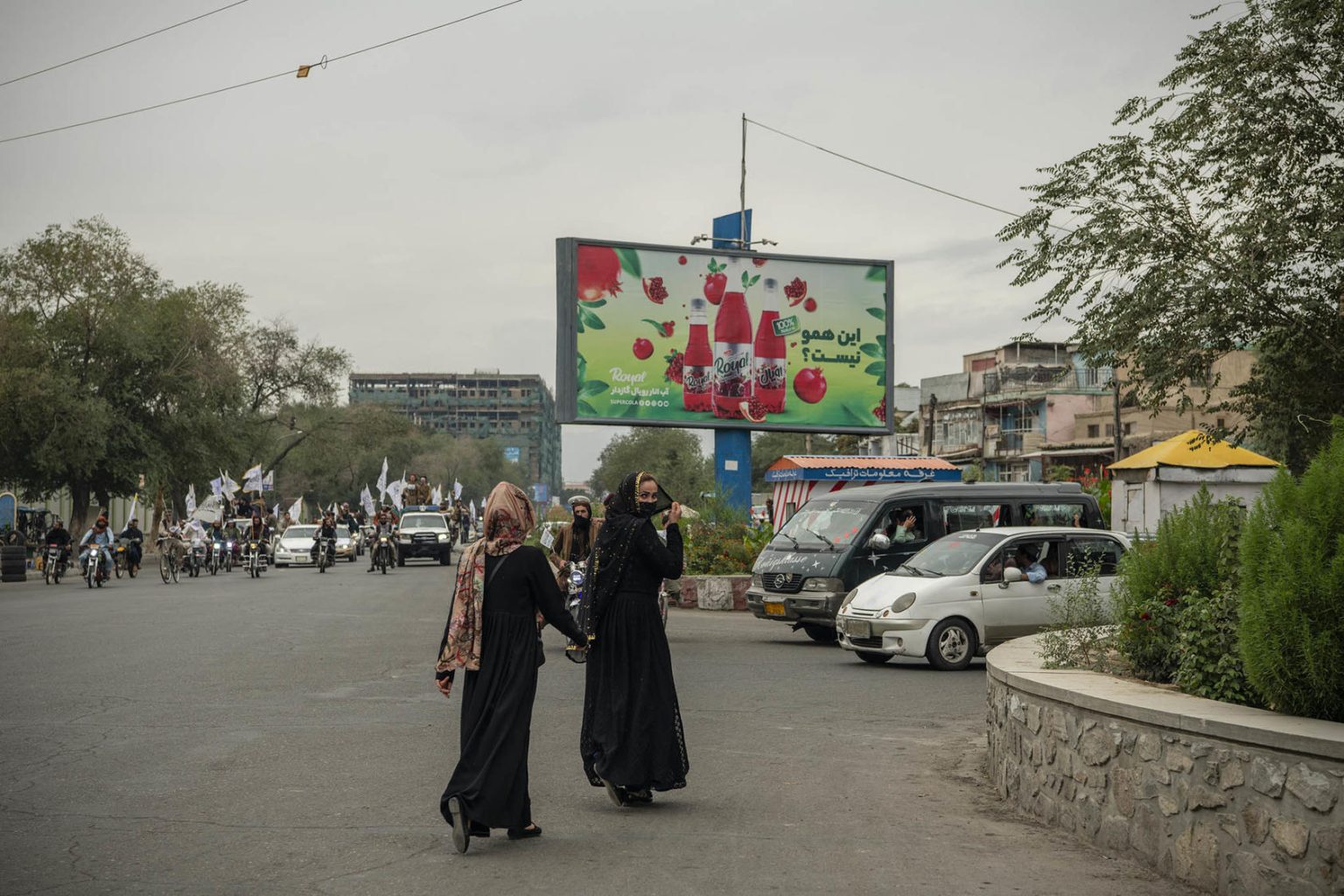[ad_1]
Advocates often apply the term “gender apartheid” to describe two-tiered systems of men making all the decisions about political and social affairs and assigning themselves agency in all public spaces while women are relegated to work that can be done from home or traditional gender roles of child-raising and homemaking. This is the situation Afghan women and girls find themselves in today.
Tightening the Noose
In the Taliban’s first press conference after taking Kabul in August 2021, spokesperson Zabiullah Mujahid said that the Taliban were “committed to the rights of women within the framework of Shariah” and that the group would not discriminate against women. While the Taliban have made similar claims in the past, these words quickly proved hollow.
Indeed, immediately after seizing power the Taliban prohibited girls from attending secondary schools and transformed the Ministry of Women’s Affairs, tasked with safeguarding women’s rights in all 34 provinces, into the ironically titled Ministry for the Prevention of Vice and Promotion of Virtue. This marked the beginning of a string of more than 140 orders and decrees that have thoroughly dismantled all existing mechanisms, laws and institutions that were put in place to protect against human rights violations and promote women’s rights.
The regime has renamed and repurposed the Attorney General’s Office, which is now called the General Directorate for Monitoring and Follow up of Decrees and Directives. The Taliban also eliminated institutions like the Afghan Independent Human Rights Commission, the Commission to Eliminate Violence Against Women, shelter and safe houses for battered women, civil society-led protection and empowerment programs and women-led organizations. They also rescinded laws and policies geared toward eliminating violence and harassment against women.
By the end of 2021, the Taliban’s first four months in power showed that they were not going to treat women any different than they did during their previous rule in the 1990s. In the early period of their current rule, Taliban decrees and edicts restricted women from working or teaching at public universities, from working for the government, or traveling beyond 45 miles away from the home without a mahram (or male guardian). The Taliban decreed that women must be accompanied by a mahram — even during surgery — while visiting male health providers
In the last two years, it continued to get worse. The Taliban decreed that the best form of hijab — which they use as a synonym for women’s covering or clothing — is for Afghan women to wear a burqa (i.e., to be fully covered from head to toe) or to simply stay home. The Taliban also banned women from working for the U.N. and NGOs and restricted women from entering public parks and participating in sports. The regime also invalidated thousands of divorce cases decided under the previous government. Their most recent decree called for the closure of beauty salons, leaving some 60,000 women without an income to support their families.
These restrictions and rules continue to be more brutal and draconian. Whereas two years ago, women could travel a short distance without a mahram, today women must have a male guardian to even leave the home. In 2021, women were banned from many jobs, but could work for NGOs or the United Nations. Today, as noted above, they cannot work for these organizations. Until December 2022, universities were open for women, but now female students and instructors are not allowed to enter public or private university campuses.A longer-term threat that has also emerged over the last two years, which would perpetuate the Taliban’s misogyny over future generations, is the “madrassafication” of the education system in Afghanistan. This has three forms: the curriculum of the regular public schools is being revised to accord with the Taliban’s interpretation of Islam; girls and boys are being encouraged to attend madrassas rather than public schools; and new “jihadi madrassas” are being created in every province that provide boys with military and Islamic education. The Taliban are also putting more investment into madrassas for both boys and girls. Parents are further incentivized to send their girls to madrassas because there are fewer harassing raids, like expelling girls under the age to 12 who are taller or physically bigger for their age.
A majority of Afghan citizens oppose the Taliban’s draconian female education restrictions and there are reports of local communities quietly looking the other way. But the Taliban have increased enforcement — establishing the Female Moral Police Department in August 2022, who are deployed to public and private educational institutions and women-only markets to inspect women’s hijab.
But Afghan women are not prepared to concede all that they had achieved over the last two decades. Many have bravely gone to the streets to demand their basic rights despite being met with Taliban violence and repression. While most public protests have largely subsided, they have been replaced with indoor protests with women and girls holding signs in Dari, Pashto and English rejecting Taliban policies. Outside the country, women have issued statements, launched media campaigns and even conducted hunger strikes to urge world leaders and the U.N. to recognize the Taliban’s gender apartheid and hold the regime accountable for crimes against humanity.
It has now been 725 days that girl students above sixth grade have not been able to attend school and 265 days since universities have stopped accepting female students. Under the Taliban today, Afghan women are deprived of their livelihoods, identity, education, employment, leisure, travel, sports and equal access to humanitarian aid. The Taliban dictate what women should or shouldn’t do in the privacy of their homes, even prohibiting listening to music. As a result, Afghan women face serious mental health issues including fear, anxiety, anger, helplessness, insomnia, lack of self-respect and thoughts of suicide and self-harm. The Taliban’s anti-women policies have emboldened the country’s patriarchal norms.
Now What?
The Taliban’s leadership has shown over the last two years that they are unwilling to deliver on the promises about women’s rights made during the Doha Agreement negotiations with the United States. Indeed, they are putting measures in place to effectuate generational change that is alien to hundreds of years of Afghan culture. The response must have equal scope and resolve: to push back with arguments, resources and accountability measures at local, national and international levels over many years.
While a parade of Islamic religious authorities has declared that both traditional and mainstream interpretations of Islam do not relegate women to being objects or second-class citizens, this argument has so far failed to overcome the Taliban’s desire for what they claim is a “100% Islamic system.”
A more pragmatic motivation for social decrees against women could be to avoid defections by the most radical of the Taliban’s supporters to ISIS or other more extreme terrorist groups. The Taliban’s success as an insurgency movement relied on recruiting young male fighters who are themselves from conservative rural areas and/or educated in radical madrassas — often in Pakistan — and were attracted to fight based in part on a call to rid Afghan society of un-Islamic Western values, particularly an alleged disrespect to women. If the Taliban do not deliver on these fighters’ visions of a so-called “pure” Islamic society, this argument goes, they may fight for ISIS and seek to overthrow the Taliban.
The problem is that the Taliban’s overriding lesson from their unexpected victory after a grueling decades-long insurgency is that loyalty is one of the most important Islamic virtues and unity is the key to success. Therefore, even though there are plenty of private dissents from important Taliban leaders over women’s rights restrictions, the religious authority of the emir, Sheikh Haibatullah Akhundzada, and the practical recognition that a divided Taliban is weak means that Haibatullah’s distasteful decrees are nonetheless obeyed.
So, what can the international community do? In the face of dogmatic Taliban resistance to change, an “all-of-the-above” strategy has the best chance of success. This should include:
- Continuing to apply public and private pressure from all sides to prevent normalization of the Taliban’s gender apartheid as other forces of change are applied.
- Giving political and financial support to international accountability mechanisms including the International Criminal Court, U.N. special rapporteur and entities documenting human rights violations.
- Providing asylum and protection to victims and survivors of Taliban’s atrocities.
- Tying international sanctions to women’s rights abuse, not just counter-terrorism rationales.
- Giving Afghan women a seat at the table in all international diplomatic fora where Afghanistan is being discussed.
- Funding women’s rights advocacy groups in Afghanistan and abroad along with supporting Afghan media to have female reporters and guests and to cover women’s rights stories.
- Funding private education of girls through all available means — online for those with internet access; underground for those with community-based “secret schools”; through scholarships at high school and university levels to study abroad.
- Amplifying messages of Islamic scholars and political leaders from Muslim majority countries that show how classical Islamic scholarship and contemporary practice in the Muslim world contradict the Taliban’s restrictive women’s rights decrees — especially to religious leaders and constituents in Afghanistan that are not Taliban but may not know about comparative Islamic practices.
A fundamental principle of international law is that the world has an obligation to combat atrocities committed in another jurisdiction, including for crimes against humanity like gender persecution and gender apartheid. To that, one can add an extra degree of moral duty for the United States and allied donor countries that created the conditions for the Taliban’s return to power without meaningful safeguards for the rights of women, which were a central objective of the West’s governance and democracy policies.
Afghan women deserve moral and material support to sustain their resiliency against the Taliban’s gender persecution. The United States and the international community should continue to firmly communicate to the Taliban that their regime’s legitimacy is dependent on protection, respect and guarantee of the rights of all Afghans regardless of their gender and social and political affiliation, and fulfillment of their obligation under international laws and conventions to which Afghanistan is a party to. The United States and the international community must make it clear that there will be legal accountability for the crimes against women that have occurred.
[ad_2]
Source link
Author Profile
Latest Entries
 SportsSeptember 30, 2023Nevin seeks to build on her promise with Leicester City – FTBL | The home of football in Australia – The Women’s Game
SportsSeptember 30, 2023Nevin seeks to build on her promise with Leicester City – FTBL | The home of football in Australia – The Women’s Game Women's RightsSeptember 30, 2023Experts back decriminalization as the best means to enhance sex workers’ rights
Women's RightsSeptember 30, 2023Experts back decriminalization as the best means to enhance sex workers’ rights  World NewsSeptember 30, 2023What risks do China’s shadow banks pose to the economy? | Business and Economy
World NewsSeptember 30, 2023What risks do China’s shadow banks pose to the economy? | Business and Economy LifestyleSeptember 30, 2023Costco has begun selling gold bars
LifestyleSeptember 30, 2023Costco has begun selling gold bars



.jpeg)


